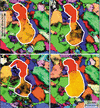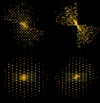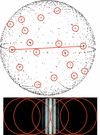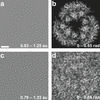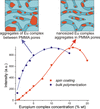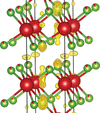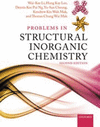issue contents
August 2019 issue
Special issue on electron crystallography
Guest Editors: Joke Hadermann and Lukáš Palatinus

Cover illustration: Courtesy of Joke Hademann and Lukáš Palatinus, with three images selected from the special issue papers of Gemmi & Lanza et al. [(2019). Acta Cryst. B75, 495–504], Rauch & Véron [(2019). Acta Cryst. B75, 505–511] and Hadermann & Abakumov [(2019). Acta Cryst. B75, 485–494].
electron crystallography
Free 

The Guest Editors of the special issue, Joke Hadermann and Lukáš Palatinus, introduce the collection of papers.
Download citation


Download citation


Open  access
access
 access
accessElectron diffraction tomography, a potential method for structure analysis of nanocrystals, and, in more detail, the strategies to use automated diffraction tomography (ADT) technique are described. Examples of ADT application are discussed according to the material class.
CCDC reference: 1915324
Methods and applications for crystallographic mapping using scanning electron diffraction in the transmission electron microscope are reviewed.
Electron diffraction tomography is optimally suited to determine the crystal structure of metal-ion battery cathode materials at different states of charge. Here the possibilities, hurdles and advantages compared to other techniques are discussed.
This a review of the different 3D electron diffraction techniques.
Numerical approaches have been developed to extract more than the dominant signal from stacks of scanning precession electron diffraction patterns. Nano-precipitates embedded in an Fe- or Al-based matrix have been properly identified with these techniques.
PETS is a computer program for processing electron diffraction data. Its features include support for detailed analysis of precession electron diffraction data, serial electron crystallography data collected with or without precession, detailed analysis of frame orientation and data processing for dynamical structure refinement.
Open  access
access
 access
accessMultiple, dynamical electron diffraction can be simulated by multislice calculations. However, experimental evidence indicates that these calculations overestimate dynamical diffraction. It is shown that ignoring bulk solvent scattering and inelastic scattering in calculations, results in overestimating dynamical effects.
A review of electron pair distribution function (ePDF) analysis is presented. A quantitative treatment of ePDF is demonstrated for a nanocrystalline anatase sample.
Three-dimensional electron diffraction proves a powerful crystallographic method for the qualitative and quantitative analysis of defective features in nanocrystalline materials. An overview of most prominent studies of defect structures using three-dimensional electron diffraction is presented.
Zn–Zr precipitates in an Mg alloy are determined to be Zn2Zr3 with a primitive tetragonal structure (space group P42/mnm, lattice parameters a = b = 0.761 nm, c = 0.682 nm) using Z-contrast imaging.
research papers
A new film material capable of transforming UV radiation into visible light was obtained from a new EuIII anisometric complex with organic ligands in a polymethylmethacrylate (PMMA) matrix and structurally characterized. From X-ray powder diffraction and small-angle scattering data, it is supposed that molecules of the EuIII complex occur in the voids of the PMMA matrix and this is accompanied by the formation of a nanocrystalline phase.
Download citation


Download citation


High-temperature study of lobanovite from a heterophyllosilicate family revealed that the mineral undergoes iron oxidation coupled with deprotonation (starting at T > 450°C) followed by rearrangement of Fe and Mg cations within close-packed octahedral layers.
Download citation


Download citation


Vernadite from ferromanganese crusts has mixed layered structures based on results from synchrotron X-ray diffraction, X-ray pair distribution function, and high-resolution transmission electron microscopy.
Download citation


Download citation


The impact of two flexible positional isomeric ligands (2- and 5-phenylimidazole) and of the coordinated inorganic anions (Cl−, I−, NO3−, NCS−) on the stoichiometry/coordination and packing arrangement of eight new cobalt(II) complexes has been thoroughly studied.
Download citation


Download citation


The tertiary structure of a somatostatin analogue, octreotide, has been identified from polycrystalline precipitates at 2.85 Å resolution.
CCDC reference: 1922522
Download citation


Download citation


Carbon nitrides include functional materials and a range of carbon nitride products obtained from the pyrolysis of NH4SCN is presented here.
Download citation


Download citation


The structure of synthetic tennantite Cu12As4S13 is investigated at various temperatures in the 90–293 K range. The refinements show significant disorder at high temperatures for the triangular coordinated copper atom and neighbouring site, and fixed atomic positions at low temperatures. One particle potential is used to describe the behaviour of atoms at these copper sites.
Download citation


Download citation


The metastable incommensurate structure of basaltic plagioclase phenocryst varies with the composition and cooling rate of the host rock, which may enable scientists to quantitatively study the thermal history of volcanic rocks in new ways.
B-IncStrDB reference: 14992E63t3B
Download citation


Download citation


The effect of varying the multiplicity of observations is explored in the context of varying acquisition time, detector binning, maximum resolution and completeness. The cost/benefit analysis suggests that, in the context of service analytical crystallography, seeking a high multiplicity of observations and including poor-quality data in a refinement do not significantly improve the result.
CCDC reference: 1870078
Download citation


Download citation


The crystal packing of known and new clofaziminium salts is presented and a conformational comparison is made.
Download citation


Download citation


Powder X-ray experiments and density functional theory calculations have been performed on RMn2O5 multiferroics under high pressure to deduce the evolution of the exchange interactions with pressure and explain the effect of pressure on the multiferroic properties.
CCDC reference: 1919948
Download citation


Download citation


Lu5Ba6B9O27 crystallizes in a new structure type in space group C2/c. The structure is disordered: one of the B atoms is surrounded by six O atoms with partial occupancies of 0.5, and this is the first example of a borate where the partial occupancy of only the O atoms is observed. Its thermal expansion is highly anisotropic. The negative linear expansion is parallel to the planes of the largest number of [BO3] triangles.
CCDC reference: 1917796
Download citation


Download citation


A reconstructive, still diffusion-less and topotactic pressure-driven phase transition of CsCoO2 is studied and an analysis of the transition pathway using ISODISTORT is presented.
CCDC reference: 1907016
Download citation


Download citation


The modulated crystal structure of the mineral daliranite has been determined using 3D electron diffraction on nanocrystalline domains.
B-IncStrDB reference: 15062EdDLkO
Download citation


Download citation


The use of scanning transmission electron microscopy (STEM) and energy-dispersive X-ray spectroscopy uncovered interstitial defects with mainly Bi character in Bi2Se3. This finding is supported by precession electron diffraction tomography and density functional theory calculations. The electron beam used during the STEM experiment induced atomic displacements across and along the van der Waals gap, though climbing-image nudged elastic band calculations show that some paths could also occur spontaneously at room temperature.
Download citation


Download citation


Open  access
access
 access
accessThe partial symmetry of low-temperature E-vanillyl oxime is analysed using space groupoids.
Download citation


Download citation


Deformation of a sublattice composed of O atoms is related to compressional anomalies of baddeleyite: softenings of bulk modulus and atom vibrations.
Download citation


Download citation


The charge-density analysis of an important metabolite has been carried out using high-resolution X-diffraction data. The study of its electrostatic properties provides insight into its binding with human serum albumin.
obituaries
Free 

book reviews
Free 



 journal menu
journal menu













